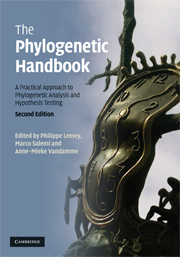Book contents
- Frontmatter
- Contents
- List of contributors
- Foreword
- Preface
- Section I Introduction
- Section II Data preparation
- Section III Phylogenetic inference
- Section IV Testing models and trees
- 10 Selecting models of evolution
- 11 Molecular clock analysis
- 12 Testing tree topologies
- Section V Molecular adaptation
- Section VI Recombination
- Section VII Population genetics
- Section VIII Additional topics
- Glossary
- References
- Index
10 - Selecting models of evolution
from Section IV - Testing models and trees
Published online by Cambridge University Press: 05 June 2012
- Frontmatter
- Contents
- List of contributors
- Foreword
- Preface
- Section I Introduction
- Section II Data preparation
- Section III Phylogenetic inference
- Section IV Testing models and trees
- 10 Selecting models of evolution
- 11 Molecular clock analysis
- 12 Testing tree topologies
- Section V Molecular adaptation
- Section VI Recombination
- Section VII Population genetics
- Section VIII Additional topics
- Glossary
- References
- Index
Summary
THEORY
Models of evolution and phylogeny reconstruction
Phylogenetic reconstruction is a problem of statistical inference. Since statistical inferences cannot be drawn in the absence of probabilities, the use of a model of nucleotide substitution or amino acid replacement – a model of evolution – becomes indispensable when using DNA or protein sequences to estimate phylogenetic relationships among taxa. Models of evolution are sets of assumptions about the process of nucleotide or amino acid substitution (see Chapters 4 and 9). They describe the different probabilities of change from one nucleotide or amino acid to another along a phylogenetic tree, allowing us to choose among different phylogenetic hypotheses to explain the data at hand. Comprehensive reviews of models of evolution are offered elsewhere (Swofford et al., 1996; Liò & Goldman, 1998).
As discussed in the previous chapters, phylogenetic methods are based on a number of assumptions about the evolutionary process. Such assumptions can be implicit, like in parsimony methods (see Chapter 8), or explicit, like in distance or maximum likelihood methods (see Chapters 5 and 6, respectively). The advantage of making a model explicit is that the parameters of the model can be estimated. Distance methods can only estimate the number of substitutions per site. However, maximum likelihood methods can estimate all the relevant parameters of the model of evolution.
Information
- Type
- Chapter
- Information
- The Phylogenetic HandbookA Practical Approach to Phylogenetic Analysis and Hypothesis Testing, pp. 345 - 361Publisher: Cambridge University PressPrint publication year: 2009
Accessibility standard: Unknown
Why this information is here
This section outlines the accessibility features of this content - including support for screen readers, full keyboard navigation and high-contrast display options. This may not be relevant for you.Accessibility Information
- 17
- Cited by
